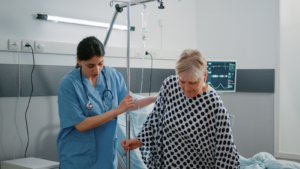Congress Newsletter 2022
How anaesthetists are driving down preventable maternal mortality
Session 04S1 Combatting maternal morbidity and mortality
Today Monday 6 June, 0930-1030H, Space 1
As part of this three-part session on Monday morning, obstetric anaesthesia Expert Dr Nuala Lucas (Northwick Park Hospital, London, UK) will examine the key messages for anaesthesia practice from the UK’s Maternal Mortality Reports which are produced annually to provide robust information about the causes of maternal deaths to promote learning and further reduce preventable maternal mortality in the UK and beyond.
She will refer extensively to the UK Maternal Mortality Enquiry programme that is led by Professor Marian Knight at the National Perinatal Epidemiology Unit at the University of Oxford and supported by clinicians from multiple disciplines in maternity care.
In the last of these reports covering 2017-19, a total of 191 women died during or up to six weeks after the end of pregnancy, from causes associated with their pregnancy, among 2,173,810 women giving birth in the UK. This translated to a rate of 8.8 women per 100,000 dying during pregnancy or up to six weeks after childbirth or the end of pregnancy – a similar rate to that seen in 2010-12, almost a decade earlier.
The data regarding ethnicity showed an alarming disparity – while the maternal mortality rate was 7 per 100,000 for white women, for Asian women this was 12 per 100,000; for mixed-race women 15 per 100,000, and for Black women a staggering 32 per 100,000 – more than four times the rate of white women. Similarly, the most deprived 20% of pregnant women, with a maternal mortality rate of 14, were twice as likely to die as those in the most affluent 20% (maternal mortality rate 7).
Prof Knight says: ‘’Our latest report acts as a reminder of the urgent action required to reduce the inequalities in maternity care that exist due to a woman’s ethnicity and socioeconomic status. This will be crucial to ensure a reduction in maternal deaths in the future.’’
The report shows that heart disease remains the leading cause of death among women during or just after pregnancy, followed by epilepsy and stroke. Sepsis and thrombosis and thromboembolism (blood clots) remain important causes of maternal death during or up to six weeks after the end of pregnancy. The maternal death rate from preeclampsia and eclampsia continues to be low but is higher than the lowest rate recorded, in 2012-14. Cancer is the most frequent cause of death for women between six weeks and a year after the end of pregnancy. Maternal suicide remains the leading direct (pregnancy-related) cause of death over the first year after pregnancy.
Dr Lucas says: “While some of these events are beyond the remit of the maternal anaesthesia teams, such as the tragedy of cancer during or just after pregnancy, there is much that we can do to further drive down maternal mortality in the UK. Even one preventable maternal death is unacceptable,” she explains.
Each pregnant woman in the UK should be assessed for the risk of blood clots using national guidelines produced by the Royal College of Obstetricians and Gynaecologists, with the maternity team, ensuring anti-clotting medication is prescribed if this is indicated. A major focus of improving outcomes is utilising primary and secondary prevention, particularly risk recognition and stratification. This is essential for women at an obviously higher risk of complications – those with heart disease.
Of course, not every complication can be prevented, and for some women, critical events like major postnatal bleeding (obstetric haemorrhage) will occur even in women without risk factors. Optimising outcomes in these situations relies heavily on ensuring ‘institutional preparedness’ in every maternity unit – the availability of staff and resources. Multidisciplinary training is now a mandatory requirement for maternity units in the NHS.
Finally, even when it looks like mother and baby are fine and all has gone well, there can be a sudden and unexpected deterioration of the mother in the recovery ward. The use of maternal early warning scores to assist with detecting acute deterioration has been a recommendation in the UK for several years. The publication of a new national maternal early warning score system is anticipated later this year.
What relevance does the UK Maternal Mortality Report have outside the UK? A United Nations Sustainable Development Goal is that by 2030, the global maternal mortality ratio (MMR) will be reduced to less than 70:100,000 live births. To achieve quality improvement in maternal health and continued reduction in MMR, it is necessary to understand the structures and processes that lead to a maternal death. This approach, described by the World Health Organization as going ‘beyond the numbers’, can be undertaken by different methodologies depending on the healthcare setting and resources. The methodology of MBRRACE-UK, the longest-running enquiry of its kind, provides an international benchmark, and many of the lessons highlighted in its reports are applicable in other healthcare settings.
Professor Knight and Dr Lucas agree that to achieve significant improvement in maternal mortality, there is a need to address mortality due to causes arising from existing disease aggravated by pregnancy. This will require increased emphasis on multidisciplinary planning and provision of care for women who have existing disease. Obstetric anaesthesia has an integral role in many aspects of maternal care beyond the provision of anaesthesia and analgesia. It has a shared responsibility for delivering safe care but is often under-represented and under-resourced in the planning of maternity care. Anaesthesia services in the maternity must be adequately resourced, which is an essential action for policymakers and service planners.
Note:
For details of the UK report, published in 2021 and covering data from 2017-19, see the links below:
Read More of our special newsletter covering our congress.











